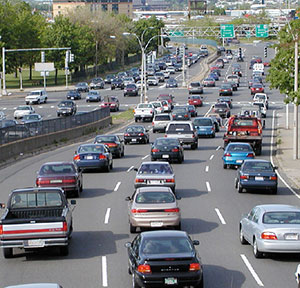Last in a three-part series
*
 By William C. Shelton
By William C. Shelton
You probably know a relative or neighbor who has asthma, emphysema, heart disease, or lung cancer. If you don’t, just wait awhile.
The air that we breathe in Somerville is among the least healthy in the state, even though we have no significant industrial sources of pollution. Traffic on I-93 and Routes 28, 38, and 99 fills our air with fine particles, air toxics, carbon monoxide, ozone, and other pollutants. Two hundred diesel trains pass through Somerville every day.
We have the most excess deaths per square mile from lung cancer and heart attacks of all Massachusetts’ cities and towns. Healy School overlooks I-93. Five large file drawers in the nurse’s office are filled with inhalers prescribed for kids with respiratory problems.
To improve air quality, it is unlikely that we will be able to close down a major highway or commuter rail line, but there are things that we can do. Six years of hard work by ordinary citizens culminated this Spring in a commitment by the Commonwealth to invest $500 million to extending the Green Line, thereby reducing Somerville traffic. This is an extraordinary victory, proving that if the people lead, our city’s leaders will eventually follow.
Unfortunately, if our leaders’ plans for Assembly Square are implemented, the air that we breathe will get significantly worse. In December, 2000, City officials gave developers Gravestar and Taurus a permit to turn the Assembly Square Mall into a giant new Home Depot, producing 550% more morning rush-hour traffic than the mall generated when it was occupied. Two years later, the Superior Court reversed this decision, saying that the city had bent the law to accommodate the developers rather than requiring them to obey the law.
 In response, Gravestar and Taurus proposed a much larger and more harmful project that included building a big-box strip mall. The city’s traffic engineering report said that the project, along with an Ikea, would create 30,000 new vehicle trips per day.[i] McGrath Highway already has serious rush-hour congestion with only 50,000 trips per day. Fine particles in the air we breathe would not only increase by 30,000 new trips. A large portion of the 50,000 vehicles that already travel Route 28 each day would drive more slowly, spewing out more toxins.
In response, Gravestar and Taurus proposed a much larger and more harmful project that included building a big-box strip mall. The city’s traffic engineering report said that the project, along with an Ikea, would create 30,000 new vehicle trips per day.[i] McGrath Highway already has serious rush-hour congestion with only 50,000 trips per day. Fine particles in the air we breathe would not only increase by 30,000 new trips. A large portion of the 50,000 vehicles that already travel Route 28 each day would drive more slowly, spewing out more toxins.
In April, 2004, Mayor Curtatone pushed through new zoning to gut Assembly Square environmental and zoning protections and exempt Gravestar from requirements to reveal the strip mall’s environmental impacts. The legislation was specifically designed to allow Gravestar to do this project.
Shopping centers generate about 43 vehicle trips per weekday and 50 per Saturday for every 1,000 square feet of building space.[ii] Big-box retail stores generate many more trips. Office space generates only about 11 trips per thousand square feet on weekdays and 2.4 on Saturdays—half that if they are served by public transit like the Orange Line.[iii]
So big boxes generate 8-to-10 times more vehicle trips than offices. They also create only one-quarter as many jobs[iv] for the same amount of building area.
When you look at land acreage instead of building square feet, the differences are much greater. Most big box acreage is parking lots. Offices require less parking, whether in lots or underground. When office buildings are multistoried, office jobs versus retail jobs per acre can be much more than 10 to 1, and the difference in daily car trips, as much as 100 to 1. Offices even create more entry-level jobs, while retail is the lowest-paid sector in Somerville.
We were told that the reason why city officials supported the mall owner’s proposal was that it would generate much-needed tax revenue for a city suffering from a structural fiscal crisis created by past development policy. It turns out that when the actual costs to the city for providing services to Assembly Square’s big boxes are subtracted from the tax revenues they create, we would suffer a net loss for as long as they existed.
In the spring of 2004, Forest City, a premier developer, was negotiating to buy out Gravestar and Taurus and do an office-based development at Assembly Square. When the aldermen passed the mayor’s rezoning, Gravestar and Taurus walked out on Forest City. They sold out their interests to Federal Realty Investment Trust and left town with $30 million in profit, the value of which was created by friendly city officials. Meanwhile, the rest of us are left to manage the traffic, nurse our loved ones, and pay the taxes that we were promised would be reduced by these developments.
[i] Rizzo Associates. Assembly Square Transportation Plan Final Report, May 13, 2003.
[ii] Institute of Transportation Engineers. Trip Generation 6th Edition, 1997. The ITE has not yet produced a manual with a big-box category in it, but traffic engineers agree that the land use generates the most number of trips.
[iii] Ibid.
[iv] See for example, Dean Schwanke, Mixed Use Development Handbook 2nd Edition, 2003; Adrienne Schmitz, et. al., Residential Development Handbook 3rd Edition, 2004; Dollars and Cents of Shopping Centers 2004; and Office Development Handbook 2nd Edition, 1998; all published by the Urban Land Institute. See also John Avault and Mark Johnson, A Summary and Survey of Development in Boston, Boston Redevelopment Authority, April, 1997.















Reader Comments